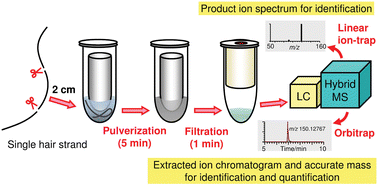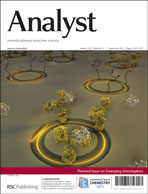An LTQ Orbitrap XL hybrid mass spectrometry method was developed for the determination of illicit drugs and their metabolites, including amphetamine (AP), methamphetamine (MA), dimethylamphetamine (DMA), 3,4-methylenedioxyamphetamine (MDA), 3,4-methylenedioxymethamphetamine (MDMA), ketamine (KET), norketamine (NK), cocaine (COC) and benzoylecgonine (BE), in hair. Micropulverized extraction was employed for sample preparation using a small hair sample (2 cm piece or 0.2 mg). Recoveries of the analytes during sample preparation were estimated using fortified hair samples and ranged from 35.5% for COC to 71.7% for AP. High resolution full-scan mass spectra and unit resolution product-ion spectra were obtained with the Orbitrap analyzer and the linear ion-trap analyzer, respectively. High-resolution extracted ion chromatograms at a tolerance of 3 ppm were utilized for quantification. The analytes were identified using the product-ion spectra in combination with the accurate masses of the corresponding protonated molecules observed in the high-resolution mass spectra. Lower limits of quantification obtained from a 0.2 mg hair sample were 0.050 ng mg−1 (MDMA, KET and BE), 0.10 ng mg−1 (AP, MA, DMA, NK and COC) and 0.50 ng mg−1 (MDA). Two reference materials were analyzed for verification, and segmental analysis of single strands of hair specimens from actual cases was performed.


 Please wait while we load your content...
Please wait while we load your content...